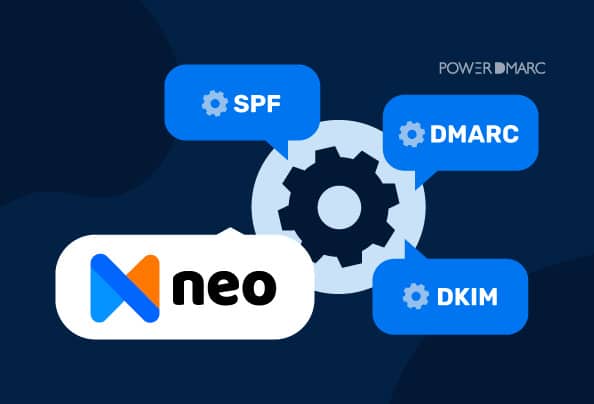When using Neo Email with your own custom domain, it’s important to configure SPF, DKIM, and DMARC records. These authentication protocols ensure that your emails are trusted by inbox providers such as Google, Yahoo, and Microsoft, thereby reducing the likelihood of them being flagged as spam or phishing.
Without proper authentication, your outgoing messages may be directed to spam folders or rejected entirely. By adding the required DNS records, you prove your domain’s identity and protect against spoofing attacks.
Steps to Set Up Neo Email Domain Authentication
Step 1: Sign Up and Access Domain Authentication
- Create a Neo Email account using the domain you want to authenticate.
- Once signed up, you’ll be taken directly to the domain authentication setup process.
- On the “Connect your domain to set up email” dialog box, click on Continue.
Neo provides two setup options: automatic and manual.
Step 2: Connect Domain Automatically
1. Neo analyzes your domain automatically to detect your DNS provider.
2. You’ll be redirected to your DNS hosting provider when you click on “Authorize with DNS Provider”
3. Log in and review the DNS records Neo suggests.
4. Click Authorize to confirm.
This option simplifies the process by letting Neo configure records on your behalf.
Step 3: Connect Domain Manually
If you prefer manual control, you can add the records yourself:
1. Click on Go to our manual setup in the domain setup dialog box.
Configuring Neo Email SPF and DKIM Records
A pop-up window will display the required records, including:
- SPF record (TXT)
- DKIM record(s) (CNAME or TXT)
- MX record (for mail routing)
- Verification record (for ownership validation)
2. Copy each record exactly as shown.
3. Log in to your domain registrar or DNS provider.
4. Add the records in your DNS zone.
Publishing Neo Email DMARC Record
Once SPF and DKIM are active, add a DMARC record to protect your domain further.
1. Login to PowerDMARC
2. Navigate to Analysis Tools > PowerToolbox > Generator Tools > DMARC Generator
3. In your DNS provider’s console, add a new TXT record with these values:
- Host/Name: _dmarc
Value (initial recommended record):
v=DMARC1; p=none; rua=mailto:dmarc-reports@yourdomain.com; ruf=mailto:dmarc-failures@yourdomain.com; sp=none; aspf=r;
4. Save the record.
5. Start with p=none (monitoring mode). This allows you to collect reports without affecting email delivery.
6. Once you review the reports and confirm that legitimate services are aligned with SPF and DKIM, you can move to stricter policies like quarantine or reject to block spoofing attempts.
Verify and Monitor Neo Email SPF, DKIM, and DMARC Records
- Wait up to 24–48 hours for DNS changes to propagate.
- Use a DMARC record checker or domain analyzer tool to confirm your SPF, DKIM, and DMARC records are correctly published.
- Monitor the reports you receive regularly to ensure no legitimate email sources are blocked.
By properly configuring SPF, DKIM, and DMARC for Neo Email, you can:
- Protect your domain against phishing and spoofing.
- Improve email deliverability and trust with recipients.
- Gain visibility into who is sending emails using your domain.
For automated monitoring, report visualization, and advanced DMARC policy management, you can simplify this process with PowerDMARC’s DMARC management platform.
- What Is BIMI? Email Trust and Brand Identity - December 26, 2025
- What Is a CAA Record? DNS Security Guide - December 24, 2025
- Is It Safe to Open Spam Emails? Risks & Safety Tips - December 16, 2025
